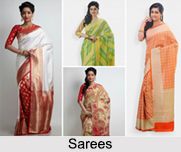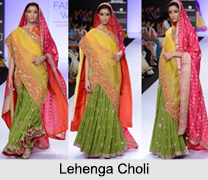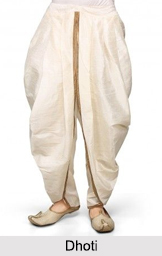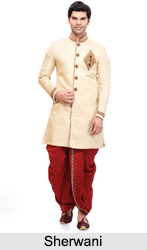 The Indian traditional costumes are as varied and diverse as the culture of the country. The many beautiful, bright and unique attires of the country vary even from state to state due to the great geographical diversity of the country. The traditional costumes in India are also worn depending on the natural fibres that are popularly grown in that particular area. Despite the current prevalence of western style of dresses, when festivities and other occasions are in vogue, Indian traditional costumes are the preferred forms of attire. An outstanding feature of the Indian traditional costumes is the bright hues and fine textures of the clothes. Every region in India is distinct in its language, lifestyle and food and this diversity is reflected in its traditional dressing as well.
The Indian traditional costumes are as varied and diverse as the culture of the country. The many beautiful, bright and unique attires of the country vary even from state to state due to the great geographical diversity of the country. The traditional costumes in India are also worn depending on the natural fibres that are popularly grown in that particular area. Despite the current prevalence of western style of dresses, when festivities and other occasions are in vogue, Indian traditional costumes are the preferred forms of attire. An outstanding feature of the Indian traditional costumes is the bright hues and fine textures of the clothes. Every region in India is distinct in its language, lifestyle and food and this diversity is reflected in its traditional dressing as well.
History of Indian Traditional Costume
A variety of weaving techniques were employed in ancient India, many of which survive to the present day. Silk and cotton were woven into various designs and motifs, each region developing its distinct style and technique. Famous among these weaving styles were the Jamdani, butidar and the Ilkal saree. Inspired by Persian designs, brocades of silk were woven with gold and silver threads. Integral to the history of the Indian traditional costume is the Kashmiri shawl, which includes the varieties of Shahtoosh, popularly known as the "ring shawl" and the pashmina wool shawls. The most prized Kashmiri shawl was the Jamavar and the Kanika Jamavar. Eventually with changing times and eras, came forth the tyrannical rule of the British Empire, after which India promoted the movement to attain self sufficiency and endorsed Indian goods while actively boycotting British products in the market. This was idealised in the production of Khadi, whose products were encouraged by the nationalist leaders over British goods, while also being seen as a means to empower the rural artisans.
Types of Indian Traditional Costume
Having evolved over time, the Indian traditional costume is not only used in daily wear but also on festive occasions as well as rituals and dance performances. The Indian traditional costume encompasses the wide variety of Indian embroidery, prints, handiwork and embellishment. Discussed elaborately below are the myriad types of Indian traditional costumes.
Saree: Ostensibly, the simplest item of clothing possible, the saree is a single length of fabric stretching up to 9m long and can be draped in a dozen of ways. The saree spans all of Indian society, from simple cotton versions that are woven in the street throughout the villages of India to extremely glamorous contemporary styles. Every region of India has its own unique saree style, with difference in terms of fabric and weaving styles. In the states of Rajasthan and Gujarat, the Bandhani Saree is a classic which involves the method of tie and dye. Then the silk sarees of Banarasi and Kanjeevaram are the quite popular among the women and are widely appreciated as an exclusively silk saree. The Banarasi Saree is the typical of Varanasi while the Kanjeevaram Silk is one of the finest silk sarees of Tamil Nadu. Other than these, there are the cotton printed and handloom sarees like the Tant, Jamdani, and Baluchari, which are common in West Bengal. These sarees are known for their lightness and are very comfortable. There are also embroidered sarees made using fabrics like georgette, chiffon, crepe and silks which gives the sarees a contemporary designer look.
Other than sarees, the other two wrap around Indian traditional clothing are Mundum Neriyathum and the Mekhela Chador. The Mundum Neriyathum is traditional Indian costume for both the men and women in Kerala and is an oldest remnant of the ancient form of saree. The conventional piece is the Mundu which is the lower garment and it consists of two cotton cloth pieces. The Mundu is worn around the hips and beneath the navel. The cloth is creamy or white in colour and possesses a coloured strip called border or Kara. The Neriyathum is the name of the upper garment which is put over the blouse having one of its ends tucked in the Mundu and the other long end worn over the front torso. This is worn in a diagonal way, from the right hips to the left shoulder and resembles a saree. While for Malayali men, they wrap the Mundu around their waist and carry the Neriyathum over their shoulder. Then there is the Mekhela Chador, which is the traditional Assamese dress worn by women of all ages. There are three main pieces of cloth that are draped around the body. The bottom portion, draped from the waist downwards is called the Mekhela, then the top portion of the three-piece dress, called the Chador. It is a long length of cloth that has one end tucked into the upper portion of the Mekhela and the rest draped over and around the rest of the body. And the third and final piece is the Riha, which is basically an odhni and is worn over the Chador.
 Salwar Kameez: Thesalwar kameez garment is essentially three- piece attire consisting of the Salwar, which is the bottom or the pants of the dress. Then there is the Kameez, which is the top or kurta and finally the duppata or the scarf. The salwar kameez is generally long and goes below the knees and has two slits on either side. The salwar is flared and narrow at the ankles and women generally wear a duppata or a scarf with it. The salwar kameez has its own various styles like the Churidar Kurta and the Anarkali. These types of attire are the traditional Indian costume of the states of Punjab and Haryana but have now spread all over the country.
Salwar Kameez: Thesalwar kameez garment is essentially three- piece attire consisting of the Salwar, which is the bottom or the pants of the dress. Then there is the Kameez, which is the top or kurta and finally the duppata or the scarf. The salwar kameez is generally long and goes below the knees and has two slits on either side. The salwar is flared and narrow at the ankles and women generally wear a duppata or a scarf with it. The salwar kameez has its own various styles like the Churidar Kurta and the Anarkali. These types of attire are the traditional Indian costume of the states of Punjab and Haryana but have now spread all over the country.
Lehenga Choli: The original traditional Indian costume of Rajasthan, the Lehenga Choli has become the main costume for all festivities and parties. The women"s ethnic wear is known by varied names like Ghagra Choli, Sharara and Chaniya Choli. It is a combination of lehenga, a tight choli and an odhani. A lehenga is a form of a long skirt which is pleated and is usually embroidered or has a thick border at the bottom. A choli is a blouse shell garment, which is cut to fit to the body and has short sleeves and a low neckline. Different styles of ghagra cholis are worn by the women, ranging from a simple cotton lehenga choli as a daily wear, a traditional ghagra with mirrors embellished usually worn during Navaratri for the garba dance or a fully embroidered lehenga worn during marriage ceremonies by the bride.
 Dhoti: Known to be the national dress of India, the dhoti is white or coloured strip of fabric stretching for about 4 to 6 feet. This traditional Indian costume is mainly worn by men, it is held in place by a style of wrapping and sometimes with the help of a belt, ornamental and embroidered or a flat and simple one, around the waist.
Dhoti: Known to be the national dress of India, the dhoti is white or coloured strip of fabric stretching for about 4 to 6 feet. This traditional Indian costume is mainly worn by men, it is held in place by a style of wrapping and sometimes with the help of a belt, ornamental and embroidered or a flat and simple one, around the waist.
Lungi: The lungi is a traditional Indian costume worn by men like a wrap around garment. There are generally two types of lungis, the open lungi and the stitched lungi. The open lungi is a plain sheet of cotton or silk, whereas the stitched one has both of its open ends stitched together to form a tube like structure. The plain white lungi is actually a Mundu and can be worn during ceremonial occasions as well as the Mundus often bear golden embroidery known as Kasavu.
 Sherwani: The Sherwani is a long coat or jacket that usually sports exposed buttons through the length of the jacket. The length of the jacket is usually just below the knees and it is known to have a Nehru collar, which is basically a collar that stands up. It is worn with tight fitted pants known as churidars. This type of traditional Indian costume is usually worn during the wedding ceremonies by the groom and is cream, light ivory or gold coloured.
Sherwani: The Sherwani is a long coat or jacket that usually sports exposed buttons through the length of the jacket. The length of the jacket is usually just below the knees and it is known to have a Nehru collar, which is basically a collar that stands up. It is worn with tight fitted pants known as churidars. This type of traditional Indian costume is usually worn during the wedding ceremonies by the groom and is cream, light ivory or gold coloured.
The variety of traditional Indian costumes is immense, and gracefully portrays an individual"s ethnicity, region, religion and sub-culture.





















